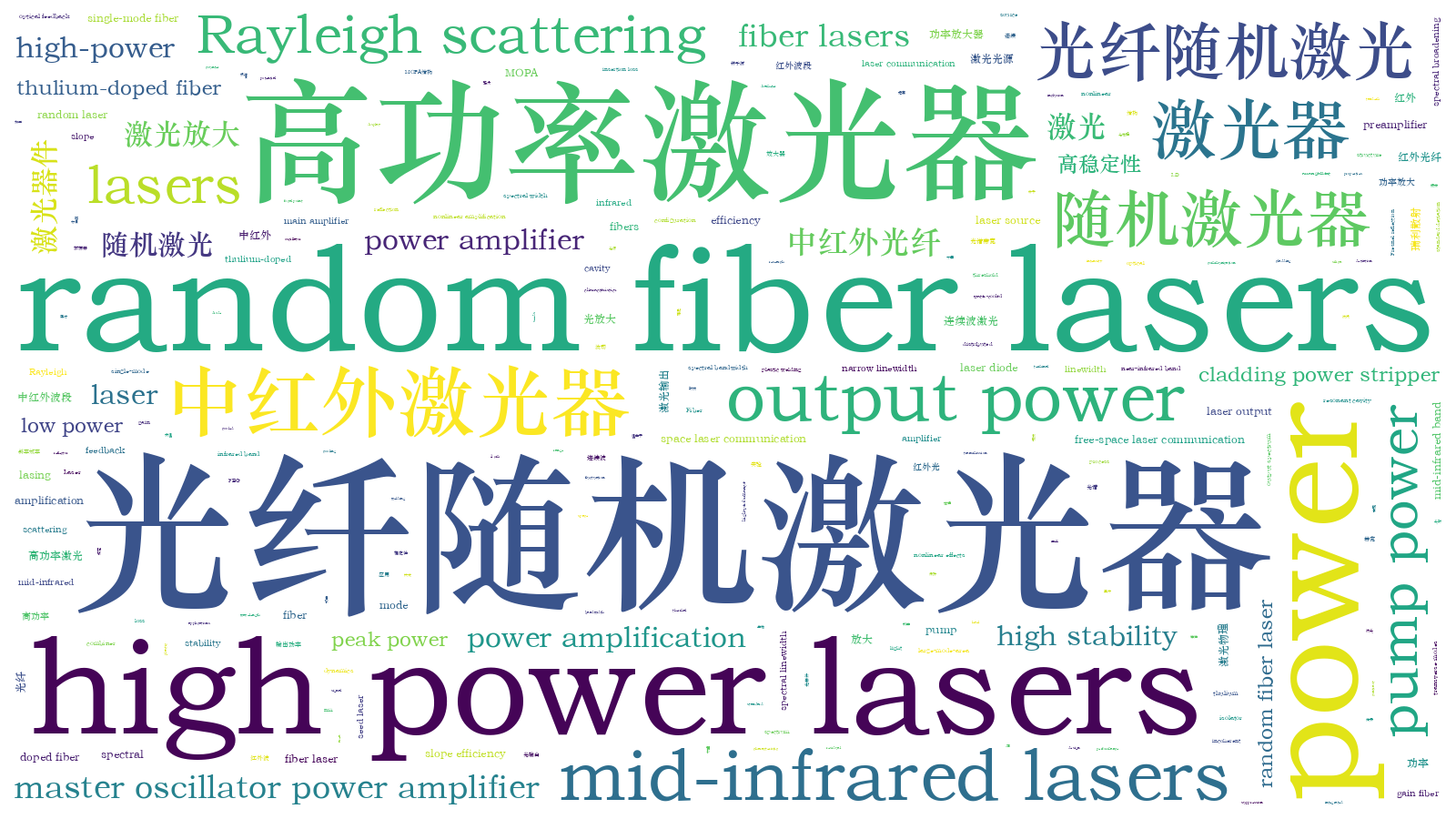百瓦级中红外光纤随机激光放大
High-power laser sources operating in 2-μm band are gaining traction due to their diverse applications, including laser scalpels, plastic welding, and free-space laser communication. Over the past decade, random fiber lasers (RFLs) have emerged as a focal point of interest. These lasers utilize randomly distributed Rayleigh scattering and nonlinear amplification, distinguishing them from traditional resonant cavity lasers. The defining features of RFLs are their open cavity structure and incoherent feedback, which result in modeless lasing and significant suppression of temporal dynamics. However, research on RFLs has primarily concentrated on the near-infrared band, specifically around 1.1 μm and 1.5 μm, due to challenges such as significant transmission loss and weaker Rayleigh scattering in mid-infrared silica-based optical fibers. Historically, RFLs in the mid-infrared band have only realized low power outputs. In this study, we introduce a high-power RFL operating at 2 μm, utilizing the master oscillator power amplifier (MOPA) approach. Impressively, we realize a peak power of 100.40 W with an efficiency slope of 47.8% and a narrow 3 dB spectral width of approximately 0.2 nm.
Figure 1 depicts the experimental arrangement for a high-powered RFL using the MOPA design. The seed consists of a 793-nm laser diode (LD), a (2+1)×1 pump combiner, a 2.4-m long thulium-doped fiber, a 1980-nm FBG, a 200-m single-mode fiber (SMF), and an isolator (ISO). The 1980-nm FBG serves as a point reflector, selecting the wavelength and providing optical feedback, in tandem with the Rayleigh scattering in the extended SMF. An isolator at the SMF end prevents unwanted light reflection. The preamplifier stage consists of a 793-nm LD, (2+1)×1 pump combiner, a 2.4-m thulium-doped fiber, and an isolator. Its role is to enhance the seed laser output power to a specified threshold. Inserting a mode-field adaptor (MFA) between the preamplifier and main amplifier minimizes insertion loss due to mode mismatch among different fibers. The main amplifier takes the laser signal from the MFA and amplifies it using a (6+1)×1 combiner and 4.7-m long large-mode-area thulium-doped fiber (LMA-TDF). This configuration facilitates a lasing output in the 100-W range, powered by two 793-nm high-intensity LDs. To remove residual pump light, a cladding power stripper (CPS) is integrated at the LMA-TDF terminal. Its endpoint is oriented to counter unintended feedback from the Fresnel reflection. Lastly, all gain fibers are positioned on a water-cooled plate for thermal efficiency. In the main amplifier stage, these fibers are coiled to approximately 10 cm in diameter, mitigating high-order transverse modes.
The RFL seeds exhibit superior lasing characteristics, which encompass a narrow spectral linewidth and exceptional temporal stability. The threshold pump power for the seed source is determined as approximately 3.57 W, with a slope efficiency of 13.6%. The standard deviation divided by the mean value (A) stands at 0.0265 with a maximum pump power of 7.40 W. This is primarily attributed to the half-opened, non-resonant structure of the seed, in contrast to a resonant cavity (Fig.2). The preamplifier stage further boosts the output power. At a pump power of 8.96 W, the maximum output power from the preamplifier stage is 3.09 W, having a slope efficiency of 35.6%. Importantly, the output spectrum of the preamplifier stage retains its narrow linewidth feature. This is a benefit of the spectral-broading-free characteristic when the random fiber laser serves as the seed in the MOPA configuration (Fig.3). In the main amplification stage, a hundred-watt-level mid-infrared lasing output materializes. With a pump power of 215.7 W, the maximum output power corresponds to 100.40 W and demonstrates a slope efficiency of 47.8%. No decline in the output power is evident, and potential for further power enhancement is predominantly constrained by laboratory cooling conditions and available pump sources (Fig.4). Notably, the output spectrum of the main amplification stage also upholds a narrow linewidth, which benefits from the unique spectral broadening-free attribute of the power amplification process founded on a half-open-cavity seed. The RFL seed output power showcases extremely minimal power fluctuations, leading to suppressed nonlinear effects. Moreover, the inclusion of a large-mode-field gain fiber in the main amplification stage aids in curtailing nonlinear effects. There is no evident spectral broadening as the output power increases from 10.33 W to 100.40 W in terms of 3 dB and 10 dB bandwidths. The 3 dB spectral bandwidth at an output power of 100.40 W is approximately 0.2 nm (Fig.5). The final laser output also demonstrates remarkable stability in short and long durations. This stability arises from the suppressed temporal dynamics induced by the incoherent feedback process via randomly distributed Rayleigh scattering. The A value decreases from 0.1419 to 0.0319 as the output power increases from 20.00 W to 100.40 W (Fig.6). Furthermore, the output power fluctuation at approximately 72 W, in terms of the A value over a 30-min interval, is only 0.0048 (Fig.7).
In this study, a high-power RFL in 2-μm band is realized using the MOPA configuration. Due to the distinctive properties of the random laser, a lasing output with a remarkably narrow linewidth (approximately 0.2 nm) is obtained. The short-term domain dynamics and long-term power fluctuations of the lasing display excellent stability. This study offers a compelling alternative for crafting a high-performance random laser source in 2-μm band.
高旺城, 马瑞, 全欣, 陈宇, 范滇元, 刘军. 百瓦级中红外光纤随机激光放大[J]. 中国激光, 2024, 51(5): 0501002. Wangcheng Gao, Rui Ma, Xin Quan, Yu Chen, Dianyuan Fan, Jun Liu. Hundred‑Watt‑Level Mid‑Infrared Random Fiber Laser Amplifier[J]. Chinese Journal of Lasers, 2024, 51(5): 0501002.







